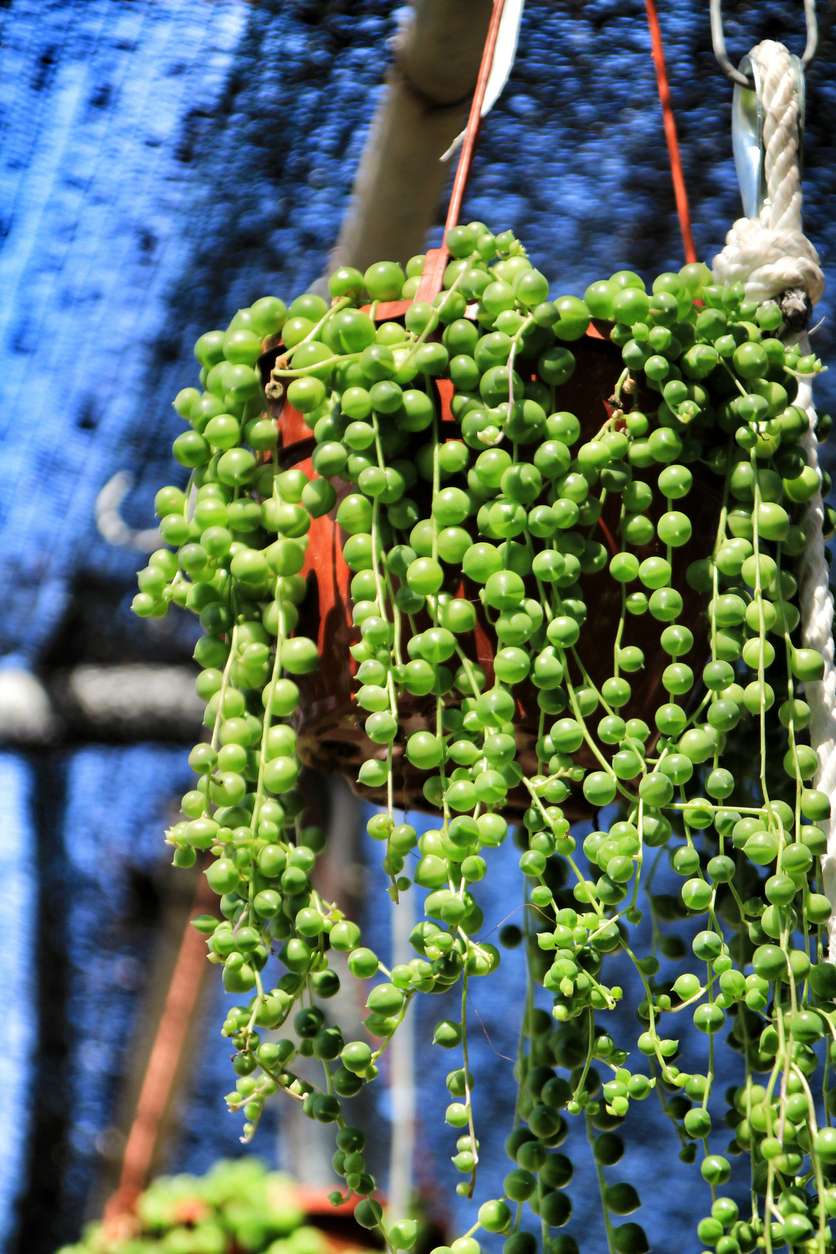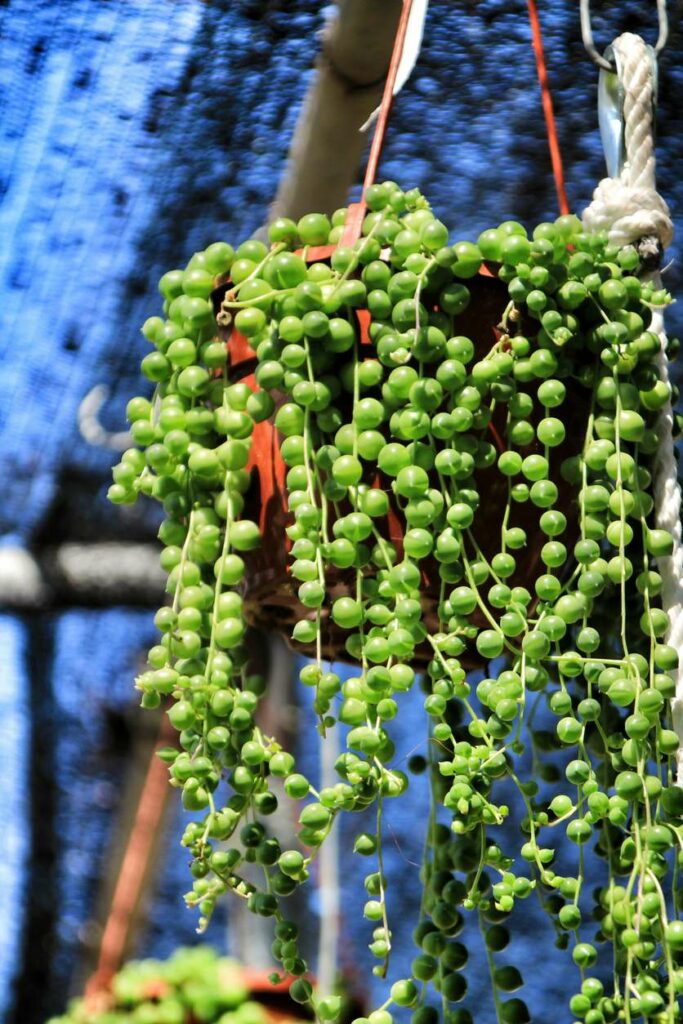String Of Pearls Care – How To Grow And Care For String Of Pearls
Some succulents have unimaginative names that hardly fit them. But the string of pearls is not of those succulents. It has all the appearances of a chandelier of pearls dangling in mid-air. Only in this case, the pearls in question are green and are very much alive.
There’s something to be said about the grace and elegance of the string of pearls spilling over the side of a hanging basket and swaying gently in your living room. The sight of the green orbs stringed together is enough to bring peace and equanimity in the most agitated mind.
Unlike many other succulents, the string of pearls takes some work to get it growing successfully. If you have experience with succulents, that prior knowledge will come in handy. This guide walks you through the process of growing the string of pearls and troubleshoots the common problems people face with this captivating succulent.
String of Pearls at a Glance
A native of Southwest Africa, the string of pearls (Senecio rowleyanus) is a drought-tolerant and hardy succulent. It grows well both indoors and outdoors as long as you pick a shady spot that doesn’t leave it under the mercy of the glare of the sun.
This vining succulent’s claim to fame lies in its green pearls. These are in fact just leaves that take the shape of an orb. There’s a practical reason behind this metamorphosis. The spherical leaves become storage tanks that hold excess water. When the rainy season ends and the soil dries out, the plant draws on its water reserves to keep going until the next rainfall.
The pearly leaves grow on stems that reach between two to three feetat a time. But that’s not all the showmanship this succulent has in store. In the summer, it starts to flower, and just like the leaves, the flowers will give you a reason to pause and wonder.
The flowers of the string of pearls are a complex affair. They have a trumpet shape and the white petals often rest on a colorful stamen. Each flower is about one inch in diameter but since they grow in clusters, the overall visual effect along with the green orbs is breathtaking.
The flowers usually stay in bloom for up to 4 weeks and fill the air with a cinnamon-like fragrance.
String of Pearls Varieties
As if all of that exquisite beauty bundled together under the name of string pearls wasn’t enough, now there are varieties to choose from. This will be a tough choice to make and I recommend you try out all the following three varieties.
- Curio radicans:It follows the same design concept of a trailing stem that carries curiously shaped leaves. The leaves in this case are shaped like fish hooks but the plant is sometimes called a string of bananas.
- Curio herreanus:Another variety with leaves shaped like melons. That’s why it earned the nickname, the string of beads. The stems are supple and dangle over the edge easily. They are covered with purple stripesfor an extra dose of color.
- Curio citriformus: If it’s difficult to choose from the above two varieties, this one with its teardrop leaves is a perfect show stopper. The white flowers stay in bloom longer than the other two varieties.
To make it easier for you, I recommend you grow all three varieties. For one thing, you couldn’t go wrong with strings of plump leaves hanging in your living room. Also, the different shapes of the leaves complement each other and compete for your attention. So from a decorative perspective, there’s no reason why you wouldn’t mix and match your string of pearl varieties.
How to Grow String of Pearls
As is the case with succulents, there’s more than one way you can start the string of pearls. However, the easiest way is to use a cutting. This saves you a lot of work and you’ll often have the plant growing in your home in no time. Here’s how to grow the string of pearls in easy steps.
- Pick a healthy stem on the bottom of a mature plant and cut about 4 inches of it using a sterile blade.
- Remove the leaves near the base of the cutting to make it easier for you to plant it.
- Fill a planter or a hanging basket with a custom potting mix. For best results, we recommend using a mixture of perlite, coarse sand, and cactus mix at a ratio of 1:1:1. This well-drained soil is ideal for the succulent.
- Dip the end of the cutting in a powdered rooting hormone to increase the chances of growing roots. Shake off the excess powder before planting.
- Dig a hole in the potting mix about 2 inches deep and plant the cutting. Make sure no leaves touch the soil.
- Fill the hole with soil and water it immediately.
- Keep the planter in a shady and well-lit place away from the direct sunlight. This protects the vulnerable cutting against sunburn.
- Mist the potting mix to make it moist for the next couple of weeks until the cutting develops roots.
- The cutting takes about a month from the time you plant it for new leaves to grow at the top.
String of Pearls Care
And that’s all the work you need to get the string of pearls started in your home. The only caveat in that otherwise straightforward process is to protect the tender cutting from the sun as it develops new roots and leaves. But even after you got the succulent to a roaring start, you still need to shield it from direct sunlight.
Soil
When it comes to the right soil for the string of pearls, you need to consider not just the soil but the container as well. Whether it’s a hanging basket, a terracotta pot, or a planter, it has to have plenty of drainage holes. The soil itself should be loamy or a custom potting mix. Either way, it has to be well-drained with pH levels around 6.0. If you don’t have loamy soil, then you can use a cactus mix with equal portions of perlite and coarse sand. And make sure the stems of the succulent don’t touch the soil to avoid rotting.
Water
Succulents are notorious for their complex watering needs. And the string of pearls is no different. If anything, this plant has a high sensitivity to excess water in the soil than many other succulents. So always let the top one inch of the soil dries out before you water it. Also, since the succulent stores water in its pulpous leaves, you won’t have to water it that often. In the summer you should water it once every couple of weeks. In the winter, cut back on irrigation to about once a month.
Light
Another issue you might have with the string of pearls care and maintenance has to do with providing adequate light. The ideal light for this succulent is bright but indirect. This is why it’s easier to grow it indoors where you can pull a thin curtain over the window to cut down the glare of the sun. If you still want to grow it outdoors, then choose a spot that gets partial shade especially in the afternoons.
Fertilizer
Usually, you won’t need to fertilize your string of pearls. It gets all the nutrients it needs from the custom potting mix you plant it in. Even around flowering time, the plant can produce an abundance of dazzling white flowers year in year out without the need for food supplements. However, if the soil itself is poor and you notice the plant could do with a boost, then use worm castings, rabbit manure tea, or banana compost. Apply the fertilizer once a year in the spring or summer. Hold back fertilizing during the fall and winter.
Common String of Pearls Problems
In addition to watering and light, you might also come across other problems pertaining to the growing and care of string of pearls. Here are some of the most common issues and what you can do to fix them.
- Crown Rot: One of the issues that people face with string of pearls is crown rot. That leaves will turn black and the stems wilt and become mushy. The reason has to do with high humidity, lack of air circulation, and misting. This succulent doesn’t need misting since it has all the water it needs right inside its plump leaves. You can use a dehumidifierto improve the air quality around the plants and prevent crow rot.
- Sunburn:We already mentioned the need to shield the plant from the direct sun. But sometimes a plant kept behind glass will also get sunburn even if it is not exposed to sunlight. The glass usually traps the heat inside which increases the temperature in the room and causes sunburn. You should improve ventilation and monitor the temperature of the room around the plant.
- Root Damage:The most obvious culprit for root damage is overfertilizing or using the wrong fertilizer. In general, your succulent doesn’t need fertilizer. But in cases of poor soil or lack of flowering, you can apply organic compost in the spring.
- Leaf Rot:This problem is related to crown rot although for a different reason. Here the leaves would rot because the stem rests on the soil and doesn’t hang over the edge of the planter. This often happens as a result of either using a planter too big for the succulent or you have planted it way too deep inside the hanging basket. Always plant the string of pearls near the edge to lift the stems and leaves off the soil.
- No Blooms:Another common problem that is the result of inadequate light or water or both. You should pay attention to the decreasing light conditions during the fall and winter. This succulent needs bright light all year round. So move it near a south- or west-facing window to get enough light all day. Another cause for the lack of flowering might be the poor soil. Consider using a phosphorus-rich fertilizer in the spring to encourage richer and brighter flowers.

